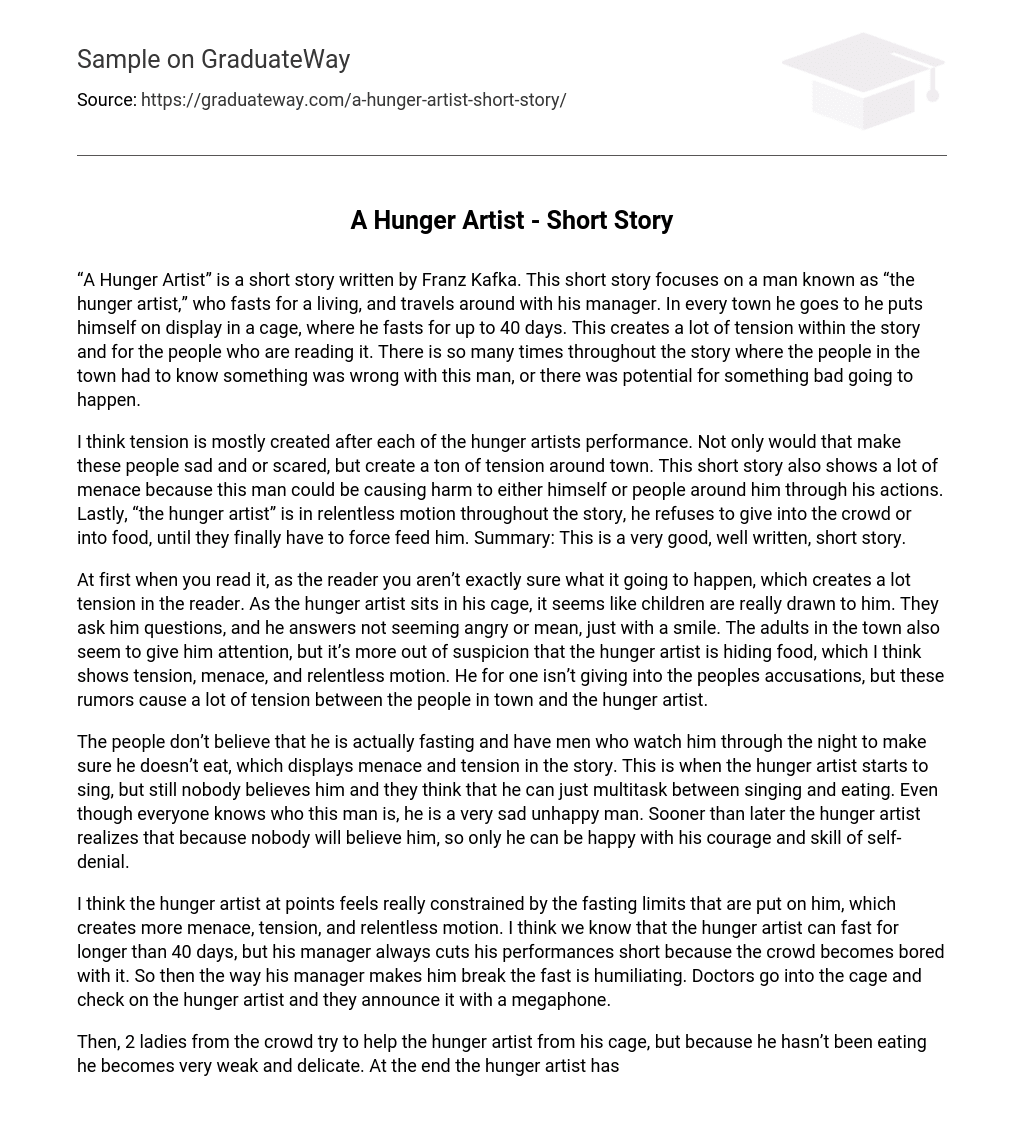“A Hunger Artist” is a short story by Franz Kafka that centers around a man known as “the hunger artist.” He earns his living by fasting and touring with his manager. In each town they visit, he showcases himself in a cage, fasting for up to 40 days. This generates significant tension within the narrative and captivates readers. Throughout the story, there are numerous instances where the townspeople must have sensed that something was amiss with this man or that there was a possibility of something unfortunate occurring.
The tension arises after each performance of the hunger artist, causing sadness, fear, and a great amount of tension in the town. This story also portrays a sense of danger as the artist’s actions may result in harm to himself or others. Moreover, throughout the story, the hunger artist remains resolutely active, refusing to succumb to the crowd or consume food until he is ultimately forcibly fed. In summary, this well-written short story is highly commendable.
Initially, readers are unsure of what will unfold, heightening tension. The hunger artist captivates children, who engage him with inquiries, and he responds kindly but evasive. Suspicion from adults in the town also surrounds him, indicating a sense of tension, threat, and constant scrutiny. Despite refusing to yield to allegations, these rumors strain relationships between townspeople and the hunger artist.
Despite the presence of men assigned to watch him and confirm his fasting, the people doubt the hunger artist’s commitment and suspect him of secretly eating. This creates an atmosphere of threat and unease in the story. Even when the hunger artist resorts to singing, nobody believes that he is truly fasting; instead, they believe he possesses the ability to simultaneously engage in multiple activities such as singing and eating. Despite being well-known, the hunger artist is profoundly despondent and discontented. Eventually, he realizes that he can find happiness solely through his bravery and mastery of self-denial, as nobody else will believe him.
The fasting limits imposed on the hunger artist make him feel restricted and enhance a sense of menace, tension, and continuous movement. Although capable of fasting for longer than 40 days, the hunger artist’s performances are regularly cut short by his manager due to audience boredom. Consequently, the manager humiliates him by having doctors enter his cage and announce the end of his fast through a megaphone.
Two ladies from the crowd attempt to assist the hunger artist as he weakens and becomes fragile due to his lack of eating. Eventually, he is compelled to consume food, depicting a sense of danger, apprehension, and ceaseless activity. Following each performance, the hunger artist is resentful when he realizes that his supposed “fans” despise him and that he could have fasted for much longer. Throughout the narrative, whenever individuals question or make remarks about him, he expresses his rage by shaking his cage, embodying menace, tension, and unyielding movement.
When the hunger artist and his manager separate, he decides to join a circus to continue his career as a professional faster. Although the audience fails to take notice of him during the performances, I believe his unwavering dedication is evident as he continues to abstain from eating, despite being aware that people are no longer interested. Ultimately, the hunger artist wastes away in his enclosure, completely disregarded and undervalued. In the end, he is discovered on the verge of death within his cage. He expresses a desire for forgiveness and admits that his only goal was to please and be admired by others, once again highlighting his unrelenting determination.
The paragraph discusses the confession of the hunger artist regarding his fasting motives, the tension it creates, and the threat it implies. It also mentions the burial of the hunger artist after his death and concludes with his replacement by a panther. The paragraph is followed by a critique of “A Hunger Artist,” stating that it is a good short story with a moral. The moral emphasizes the dangers of pride and the hunger artist’s resistance to cultural change. The pride he possesses leads to his dissatisfaction in life and ultimately results in his death. Despite his honesty and achievement of his goals without cheating, he yearns for others to acknowledge his accomplishments.
The hunger artist’s lack of fulfillment stems from his pride as he only seeks satisfaction from others. Consequently, he dies without ever truly being satisfied. He refuses to change himself or those around him, and his art lacks significant impact. Despite this, he continues on, showcasing his unyielding persistence. It is intriguing that none of the characters in “A Hunger Artist” are named, intensifying the tension. Ultimately, the short story delves into the hunger artist’s struggle, unattained aspirations, and eventual demise.
The text suggests that if we don’t let go of our pride, we may end up with an unsatisfying and unfulfilling life. When you have a passion for something and want to excel in it, you are willing to go to great lengths to achieve it. The hunger artist always pushed himself beyond his perceived limits. In my opinion, this short story implies that only you truly know yourself. I found the various meanings in this story interesting, and Kafka effectively captured the tension, threat, and constant movement throughout.





